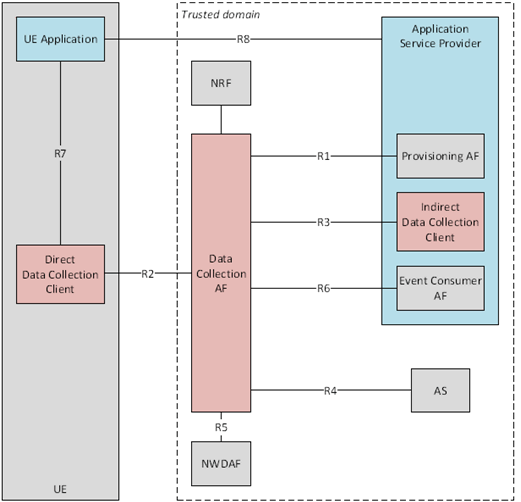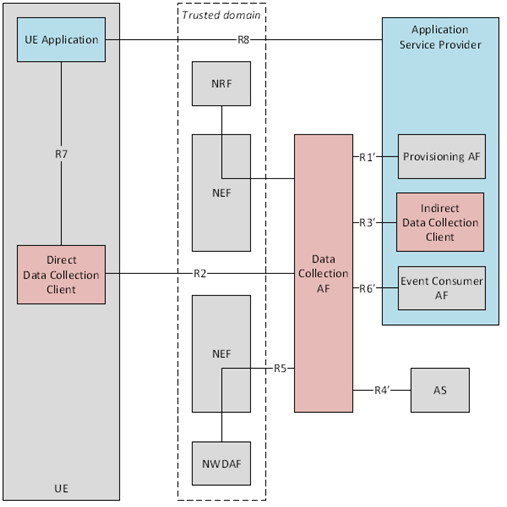Content for TS 26.531 Word version: 18.2.0
A Collaboration scenarios for data collection and reporting
A.1 General
A.2 Collaboration A
A.3 Collaboration B
A.4 Collaboration C
A.5 Collaboration D
A.6 Collaboration E
B UE data domain ownership
B.1 General
B.2 Baseline UE data domains
$ Change history
A Collaboration scenarios for data collection and reporting p. 31
A.1 General p. 31
This annex documents a set of collaboration scenarios that illustrate potential deployments of the data collection and reporting architecture as defined in the present document.
In deployment, it is possible that some UE data is provided to the Data Collection AF using the direct data reporting method at reference point R2, while other (application-private) UE data is collected via reference R8 and provided to the Data Collection AF via the indirect data reporting method at reference point R3 (R3' in Collaboration D). In certain domains, UE data is collected in the first instance by an AS and therefore needs to be provided to the Data Collection AF at reference point R4 (R4' in Collaboration D). Hence, all three data reporting reference points are potentially in scope for all of the documented collaboration scenarios.
A.2 Collaboration A p. 32
In this collaboration scenario all of the functions are deployed inside the trusted domain. This corresponds to the case where the functional entities of the Application Service Provider as well as the Application Server (AS) are internal to the 5G System.

Figure A.2-1: Collaboration A with all functions deployed inside the trusted domain
(⇒ copy of original 3GPP image)
(⇒ copy of original 3GPP image)
A.3 Collaboration B p. 33
In this collaboration scenario the functional entities of the Application Service Provider are deployed outside the trusted domain. Interactions between these functions and the Data Collection AF must therefore be mediated by the NEF.

Figure A.3-1: Collaboration B with all functions of Application Service Provider deployed outside the trusted domain
(⇒ copy of original 3GPP image)
(⇒ copy of original 3GPP image)
A.4 Collaboration C p. 34
This collaboration scenario illustrates the case where the Application Server (AS) is also deployed outside the trusted domain (in addition to the functional entities of the Application Service Provider per Collaboration B). In this case, the AS must therefore additionally interact with the Data Collection AF via the NEF.

Figure A.4-1: Collaboration C with all functions of Application Service Provider and Application Server deployed outside the trusted domain
(⇒ copy of original 3GPP image)
(⇒ copy of original 3GPP image)
A.5 Collaboration D p. 35
In this collaboration scenario, the Data Collection AF itself is deployed outside the trusted domain and interactions with functions inside the trusted domain occur via the NEF. This scenario corresponds to the "Procedure for Data Collection from AF via NEF" defined in clause 6.2.2.3 of TS 23.288. Specifically:
-
The externally deployed Data Collection AF registers with the NRF inside the trusted domain using the Nnef_
NFManagement service via the NEF. -
The NWDAF inside the trusted domain uses the Nnef_
EventExposure service (as specified in clause 5.2.6.2 of TS 23.502) to subscribe to and receive events exposed by the externally deployed Data Collection AF.

Figure A.5-1: Collaboration D with Data Collection AF deployed outside the trusted domain
(⇒ copy of original 3GPP image)
(⇒ copy of original 3GPP image)
The functional entities of the Application Service Provider, as well as the Application Server (AS), interact with the externally deployed Data Collection AF using interfaces that are outside the scope of 3GPP specification. However, the interactions at reference points R1', R3', R4' and R6' are expected to be functionally equivalent to those at R1, R3, R4 and R6 respectively.
A.6 Collaboration E p. 36
In this collaboration scenario, the Data Collection Client is deployed as a subfunction of the UE Application. As a consequence of this arrangement, reference point R7 is subsumed into the UE Application.
This collaboration may be combined with any of the preceding collaboration scenarios. Hence, only reference points R2 and R8 are depicted in the Figure in the interests of brevity.

Figure A.6-1: Collaboration E with Data Collection Client deployed as part of the UE Application
(⇒ copy of original 3GPP image)
(⇒ copy of original 3GPP image)
The Direct Data Collection Client could, for example, be realised as a software library that implements the appropriate protocol at reference point R2. In such a realisation, the procedures defined in the present document at reference point R7 would likely form the API of the Data Collection Client library.
B (Normative) UE data domain ownership p. 37
B.1 General p. 37
Ownership of any UE data domain not listed in this Annex shall be specified in the document defining that domain.
B.2 Baseline UE data domains p. 37
Table B.2-1 specifies ownership of the baseline UE data domains defined in TS 23.288.
| UE data domain | Owner |
|---|---|
| Service Experience | 5G System (MNO) |
| UE Location | 5G System (MNO) |
| Communication | 5G System (MNO) |
| Performance | 5G System (MNO) |
| Planned Trips | 5G System (MNO) |
Application-specific UE data domains shall be owned by the ASP.